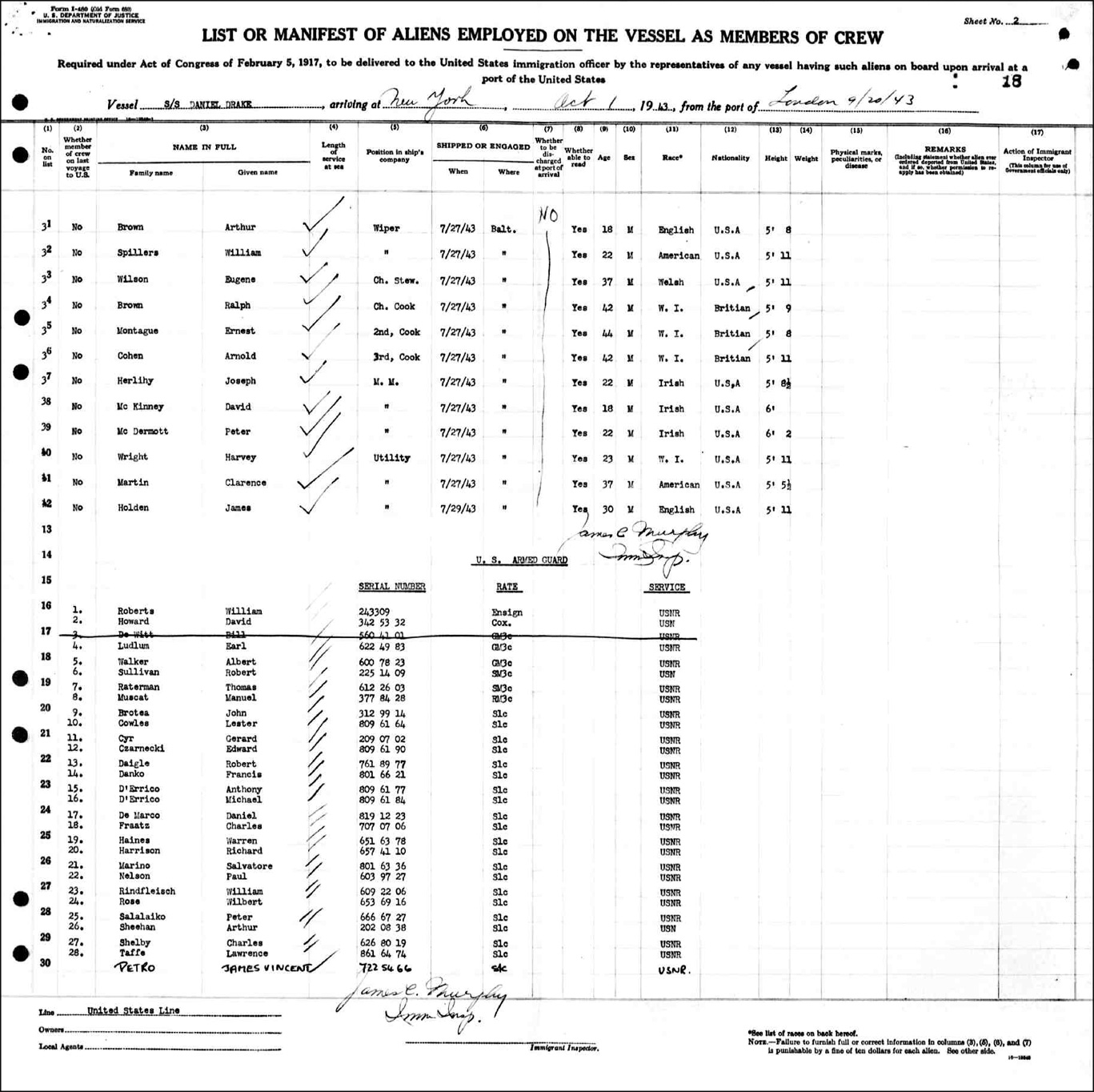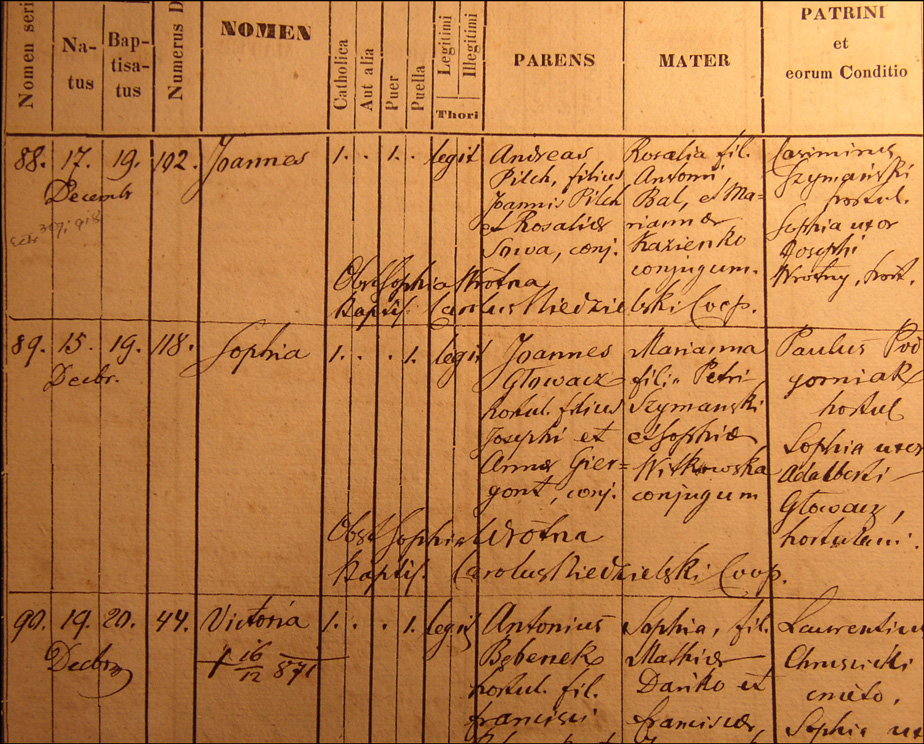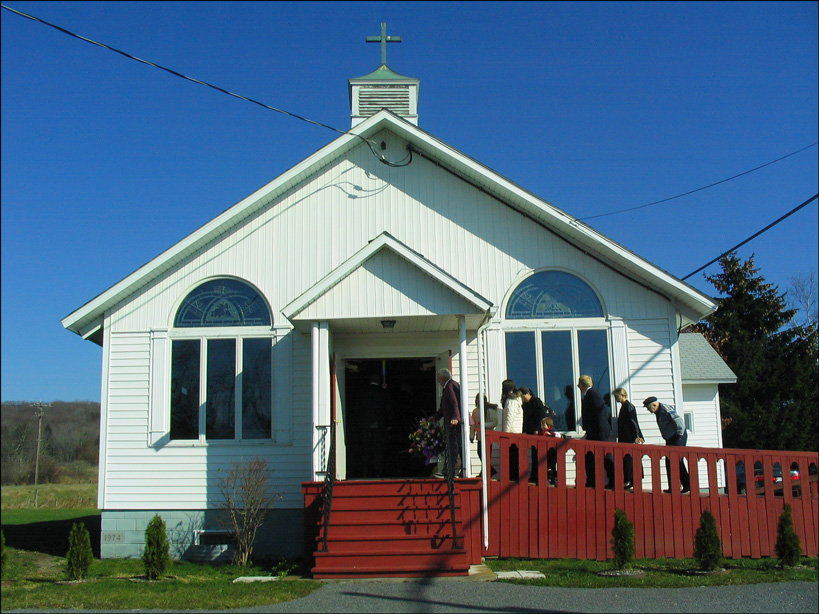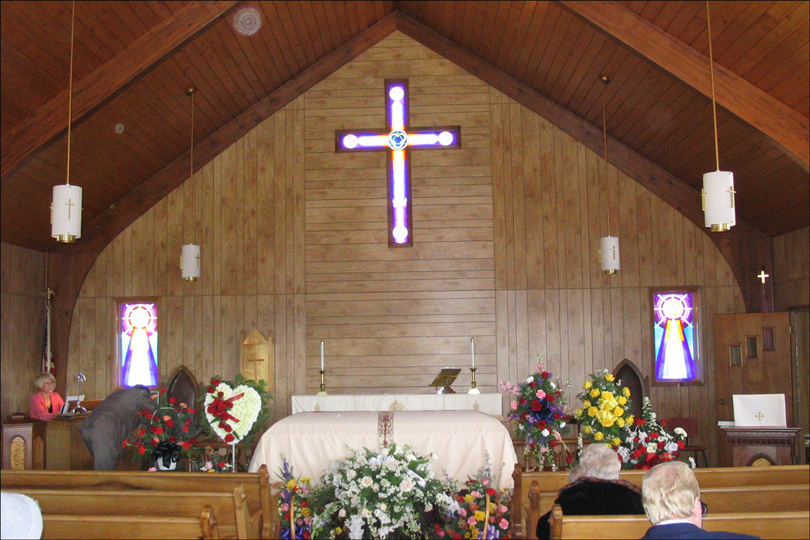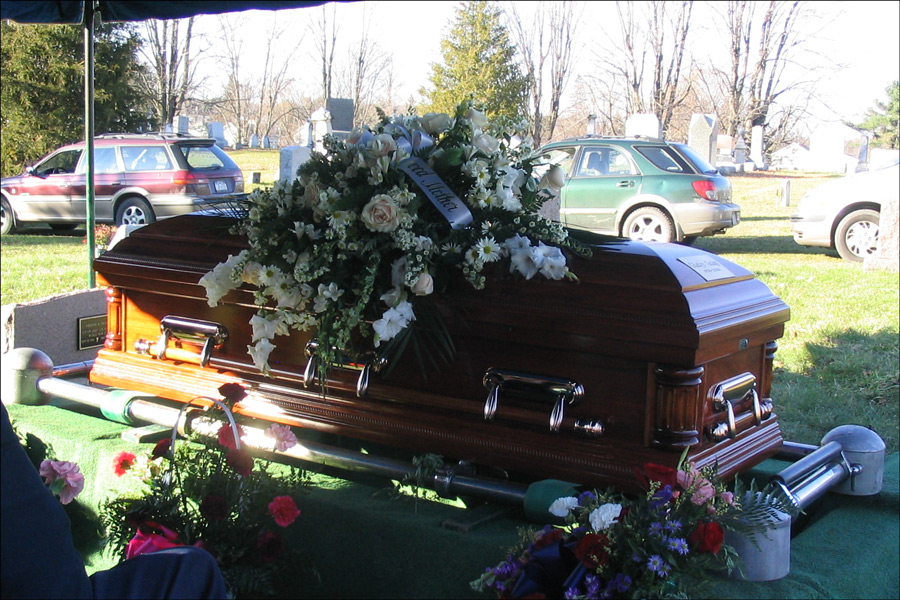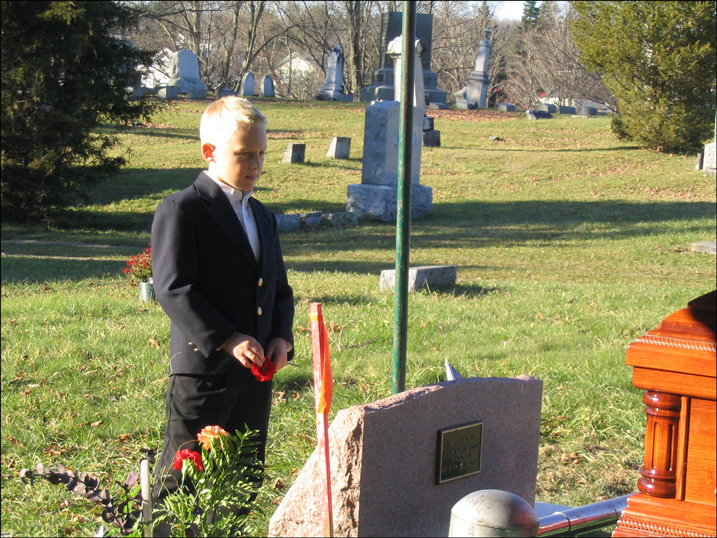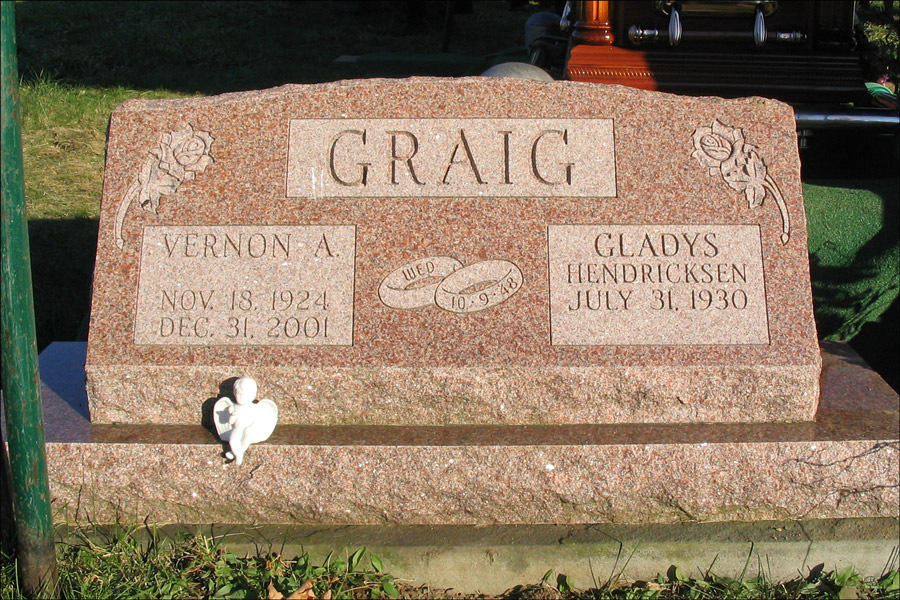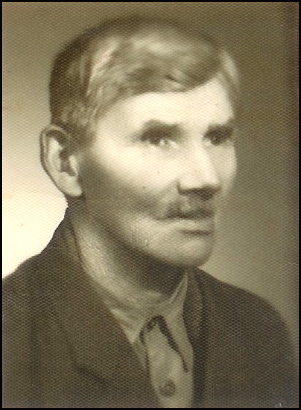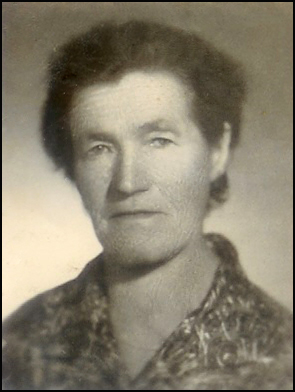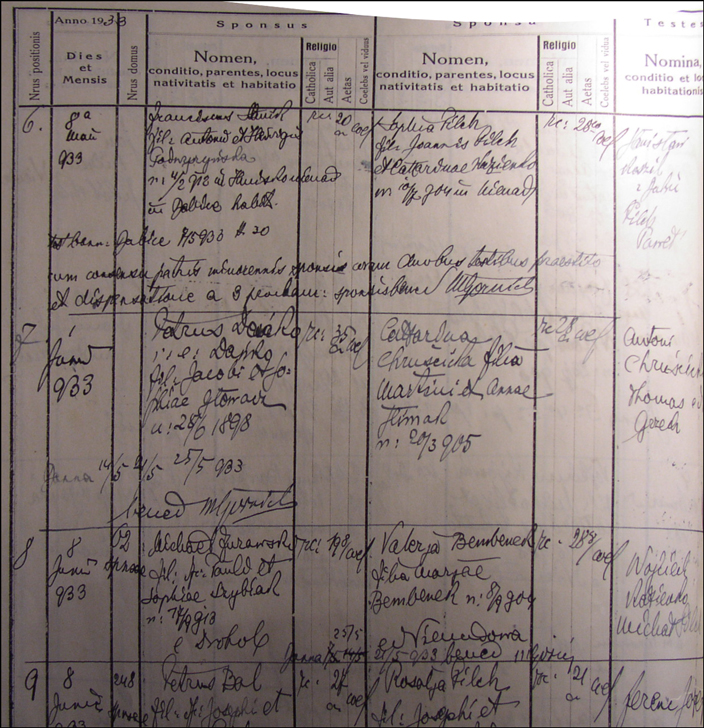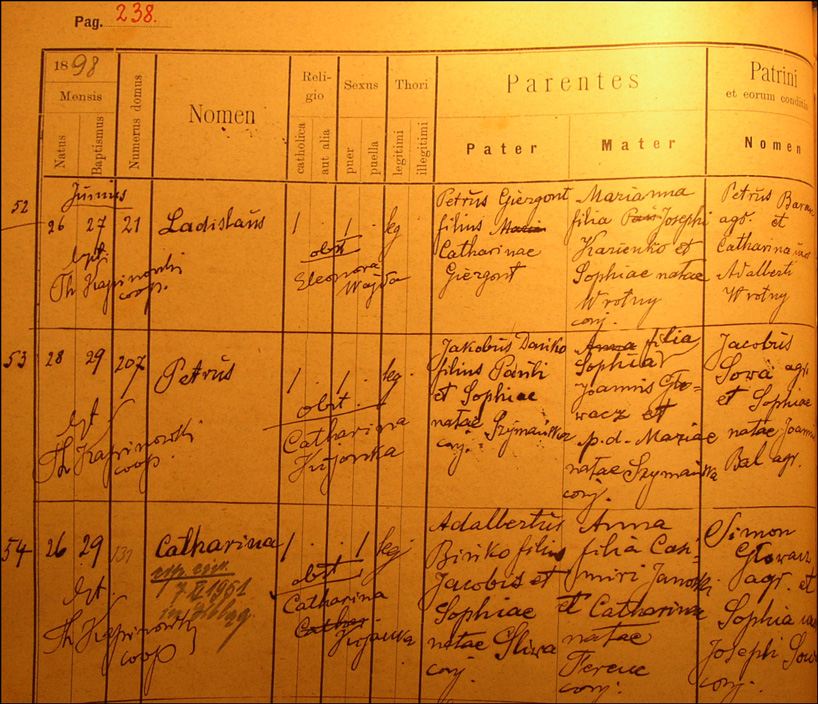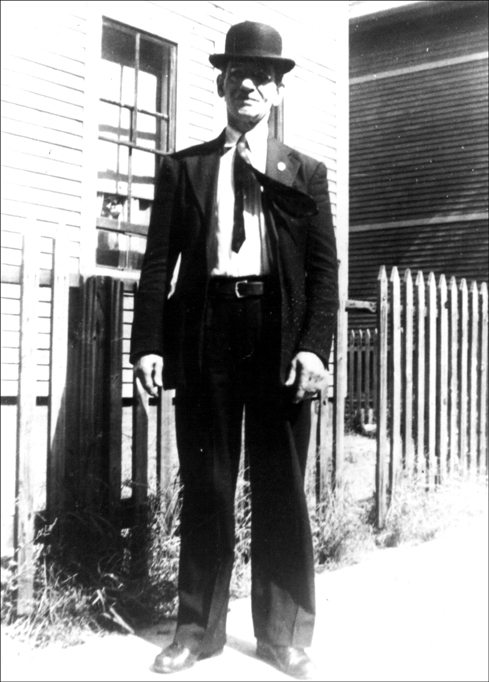I’ve been able to trace my Dańko ancestors as far back in time as the Parish Records were maintained (the late 1700’s) . Since I’ve blogged about these records for several months now, I thought it would be useful to publish the family history with links to the various records that I’ve already discussed.
This history does not include information on living individuals.
Descendants of Józef Dańko
Generation No. 1
1. JÓZEF DAŃKO was born about 1717, and died 26 Oct 1787 in Nienadowa, Powiat Przemyski, Galicia, Austria-Poland.
Child of JÓZEF DAŃKO is:
2. i. WOJCIECH DAŃKO was born between 1770 – 1772; died 28 Dec 1853, Nienadowa, Powiat Przemyski, Galicia, Austria-Poland.
Generation No. 2
2. WOJCIECH DAŃKO (JÓZEF) was born about 1769 – 1772, and died 28 Dec 1853 in Nienadowa, Powiat Przemyski, Galicia, Austria-Poland. He married (1) MARIANNA JEDLIŃSKA 11 Nov 1793 in Dubiecko, Powiat Przemyski, Galicia, Austria-Poland, daughter of WOJCIECH JEDLIŃSKI . She was born about 1771 – 1772 and died between 1816 – 1818. He married (2) ROZALIA CHRUŚCICKA 06 Jul 1818 in Dubiecko, Powiat Przemyski, Galicia, Austria-Poland, daughter of JÓZEF CHRUŚCICKI. She was born about 1796 in Galicia, Austria-Poland and died before 1854.
Children of WOJCIECH DAŃKO and MARIANNA JEDLIŃSKA are:
i. PAWEL DAŃKO, baptized 01 Jul 1796, Nienadowa, Powiat Przemyski, Galicia, Austria-Poland; probably died before 1799, Nienadowa, Powiat Przemyski, Galicia, Austria-Poland.
3. ii. PAWEL DAŃKO, baptized 04 Jan 1799, Nienadowa, Powiat Przemyski, Galicia, Austria-Poland; died 31 Jul 1850, Nienadowa, Powiat Przemyski, Galicia, Austria-Poland.
iii. WIKTORIA DAŃKO, baptized 06Â Dec 1800, Nienadowa, Powiat Przemyski, Galicia, Austria-Poland.
iv. ROZALIA DAŃKO, baptized 10 Aug 1804, Nienadowa, Powiat Przemyski, Galicia, Austria-Poland.
v. MACIEJ DAŃKO, baptized 01 Jan 1808, Nienadowa, Powiat Przemyski, Galicia, Austria-Poland.
vi. STANISŁAW DAŃKO, baptized 07 May 1810, Nienadowa, Powiat Przemyski, Galicia, Austria-Poland.
vii. MICHAŁ DAŃKO, born 22 Sep 1816, Nienadowa, Powiat Przemyski, Galicia, Austria-Poland.
Children of WOJCIECH DAŃKO and ROZALIA CHRUSCICKA are:
4. viii. ANDRZEJ DAŃKO, born 16 Dec 1819, Nienadowa, Powiat Przemyski, Galicia, Austria-Poland.
ix. MARIA DAŃKO, born 27 Mar 1822, Nienadowa, Powiat Przemyski, Galicia, Austria-Poland.
x. JAN DAŃKO, born 12 Nov 1824, Nienadowa, Powiat Przemyski, Galicia, Austria-Poland.
xi. JAKUB DAŃKO, born 23 Jul 1827, Nienadowa, Powiat Przemyski, Galicia, Austria-Poland.
xii. WIKTORIA DAŃKO, baptized 27 Jul 1830, Nienadowa, Powiat Przemyski, Galicia, Austria-Poland.
xiii. ANNA DAŃKO, born 26 May 1833, Nienadowa, Powiat Przemyski, Galicia, Austria-Poland.
Generation No. 3
3. PAWEL DAŃKO (WOJCIECH, JÓZEF) was baptized 04 Jan 1799 in Nienadowa, Powiat Przemyski, Galicia, Austria-Poland, and died 31 Jul 1850 in Nienadowa, Powiat Przemyski, Galicia, Austria-Poland. He married ZOFIA SZYMAŃSKA 20 Nov 1825 in Dubiecko, Powiat Przemyski, Galicia, Austria-Poland, daughter of ANDRZEJ SZYMAŃSKI and ANNA UNKNOWN. She was born about 1808.
Children of PAWEL DAŃKO and ZOFIA SZYMAŃSKA are:
i. MARIANNA DAŃKO, born 13 Dec 1826, Nienadowa, Powiat Przemyski, Galicia, Austria-Poland.
ii. SZYMON DAŃKO, born 17 Oct 1829, Nienadowa, Powiat Przemyski, Galicia, Austria-Poland.
iii. KATARZYNA DAŃKO, born 22 Sep 1832, Nienadowa, Powiat Przemyski, Galicia, Austria-Poland.
iv. PAWEL DAŃKO, born 19 Jan 1835, Nienadowa, Powiat Przemyski, Galicia, Austria-Poland.
v. AGNIESZKA DAŃKO, born 06 Jan 1838, Nienadowa, Powiat Przemyski, Galicia, Austria-Poland.
vi. TOMASZ DAŃKO, born 07 Dec 1840, Nienadowa, Powiat Przemyski, Galicia, Austria-Poland.
5. vii. JAKUB DAŃKO, born 02 Jul 1843, Tuligłowy, Powiat Przemyski, Galicia, Austria-Poland; died 15 Mar 1899, Nienadowa, Powiat Przemyski, Galicia, Austria-Poland.
viii. JADWIGA DAŃKO, born 09 Sep 1847, Nienadowa, Powiat Przemyski, Galicia, Austria-Poland.
4 . Â ANDRZEJ DAŃKO (WOJCIECH, JÓZEF) was born 16 Dec 1819 in Nienadowa, Powiat Przemyski, Galicia, Austria-Poland. He married JADWIGA PANOWSKA, daughter of MARCIN PANOWSKI.
Children of ANDRZEJ DAŃKO and JADWIGA PANOWSKA are:
 i. ROZALIA DAŃKO, born 01 Sep 1847, Nienadowa, Powiat Przemyski, Galicia, Austria-Poland.
Generation No. 4
5. JAKUB DAŃKO (PAWEL, WOJCIECH, JOZEF) was born 02 Jul 1843 in Nienadowa, Powiat Przemyski, Galicia, Austria-Poland, and died 15 Mar 1899 in Nienadowa, Powiat Przemyski, Galicia, Austria-Poland. He married (1) AGNIESZKA SOWA 18 Jul 1870 in Dubiecko, Galicia, Austria-Poland, daughter of MACIEJ SOWA and KATARZYNA JACHOWA, who were married 28 May 1844 in Dubiecko, Galicia, Austria-Poland. She was born 06 Jan 1855 in Nienadowa, Powiat Przemyski, Galicia, Austria-Poland, and died between 20 Jun 1895 – 03 Sep 1896 in Nienadowa, Powiat Przemyski, Galicia, Austria-Poland. He married (2) ZOFIA GŁOWACZ 03 Sep 1896 in Dubiecko, Powiat Przemyski, Galicia, Austria-Poland, daughter of JAN GŁOWACZ and ZOFIA SZYMAŃSKA. She was born 15 Dec 1870 in Nienadowa, Powiat Przemyski, Galicia, Austria-Poland.
Children of JAKUB DAŃKO and AGNIESZKA SOWA are:
6. i. MICHAEL JACOB DAŃKO, born 22 Sep 1877, Nienadowa, Powiat Przemyski, Galicia, Austria-Poland; died 02 Jan 1953, Worcester, Worcester Co., Massachusetts.
ii. JÓZEF J. DAŃKO, born about 1880.
iii. WOJCIECH DAŃKO, born 18 Sep 1882, Nienadowa, Powiat Przemyski, Galicia, Austria-Poland.
7. iv. MARY AGNES DAŃKO, born 12 Jan 1884, Nienadowa, Powiat Przemyski, Galicia, Austria-Poland; died 18 Sep 1975, Fairlawn Hospital /Worcester, Worcester Co., Massachusetts.
v. JAN DAŃKO, born 18 May 1886, Nienadowa, Powiat Przemyski, Galicia, Austria-Poland.
vi. KATARZYNA DAŃKO, born 21 Feb 1887, Nienadowa, Powiat Przemyski, Galicia, Austria-Poland.
8. vii. MARCIN DANKO, born 11 Dec 1890, Nienadowa, Powiat Przemyski, Galicia, Austria-Poland.
viii. JULIANNA DAŃKO, born 20 Jun 1895, Nienadowa, Powiat Przemyski, Galicia, Austria-Poland.
Child of JAKUB DAŃKO and ZOFIA GŁOWACZ is:
9. ix. PIOTR DAŃKO, born 28 Jun 1898, Nienadowa, Powiat Przemyski, Galicia, Austria-Poland; died England, United Kingdom.
Generation No. 5
6. MICHAEL JACOB DAŃKO (JAKUB, PAWEL, WOJCIECH, JÓZEF) was born 22 Sep 1877 in Nienadowa, Powiat Przemyski, Galicia, Austria-Poland, and died 02 Jan 1953 in Worcester, Worcester Co., Massachusetts, United States of America. He married MARIANNA DZIURZYŃSKA 14 Aug 1898 in Powiat Przemyski, Galicia, Austria-Poland, daughter of JAN DZIURA and MAGDALENA JARA who were married 16 Sep 1875 in Dubiecko, Powiat Przemyski, Galicia, Austria-Poland. Marianna was born 14 Aug 1881 in Sielnica, Powiat Przemyski, Galicia, Austria-Poland, and died 08 Sep 1969 in St. Peter’s Hospital /Albany, Albany Co., New York, United States of America
Children of MICHAEL DAŃKO and MARIANNA DZIURZYŃSKA are:
i. SOPHIA MARY DAŃKO, born 12 Jan 1901, Nienadowa, Powiat Przemyski, Galicia, Austria-Poland; died 06 Oct 1977, Albany, Albany Co., New York; married CLARK GIBSON, between 12 Jan – 19 Jun 1923; born 20 Jun 1894, Fairfield, Franklin Co., Vermont, United States of America; died 19 Jan 1984, Guilderland Center Nursing Home /Albany, Albany Co., New York, United States of America.
ii . KAROL DAŃKO, born about 02 Apr 1902, Galicia, Austria-Poland; died before May 1909, Galicia, Austria-Poland.
iii. JOHN JOSEPH DAŃKO, born 02 May 1905, Nienadowa, Powiat Przemyski, Galicia, Austria-Poland; died 30 Dec 1962, Albany, Albany Co., New York, United States of America; married ALICE HARRIET EUGENIA CHARRON, 27 Jun 1935, Ste. Maries Church /Cohoes, Albany Co., New York, United States of America; born 01 Oct 1904, Cohoes, Albany Co., New York, United States of America; died 25 Sep 1992, St. Peter’s Hospice /Albany, Albany Co., New York, United States of America.
iv. STATIA FRANCES DANKO, born 13 May 1910, Worcester, Worcester Co., Massachusetts, United States of America; died 21 Oct 1979, Albany, Albany Co., New York, United States of America; married ALFRED ALOYSIUS IWANIEC, SR., 29 Sep 1934, Albany, Albany Co., New York, United States of America; born 24 Sep 1914, Mount Vernon, Westchester Co., New York, United States of America; died 11 Sep 1964, Albany, Albany Co., New York, United States of America.
v. BRONISLAWA DANKO, born 03 Jan 1912, Worcester, Worcester Co., Massachusetts, United States of America; died 13 Jan 1913, Worcester, Worcester Co., Massachusetts, United States of America.
vi. MICHAEL JOHN DANKO, born 13 Sep 1913, Worcester, Worcester Co., Massachusetts, United States of America; died 19 Nov 1981, 15 Marion Avenue /Worcester, Worcester Co., Massachusetts, United States of America; married JEAN BARBARA SKOWRONSKI, 12 Jul 1952, St. Marys Church /Worcester, Worcester Co., Massachusetts, United States of America; born 31 Mar 1917, Worcester, Worcester Co., Massachusetts, United States of America; died 18 Oct 1996, Memorial Health Care /Worcester, Worcester Co., Massachusetts, United States of America.
vii. BERTHA THERESA DANKO, born 28 Oct 1915, Worcester, Worcester Co., Massachusetts, United States of America; died 29 Jul 1978, The Memorial Hospital /Worcester, Worcester Co., Massachusetts, United States of America; married GEORGE EDWARD JOSEPH MCGINN, 20 Oct 1934, Worcester, Worcester Co., Massachusetts, United States of America; born 23 Sep 1908, Fredericton, York Co., New Brunswick, Canada; died 21 Mar 1981, Worcester, Worcester Co., Massachusetts, United States of America.
viii. MARY THERESA DANKO, born 07 Oct 1917, Worcester, Worcester Co., Massachusetts, United States of America; died 05 Jan 1986, Hahnemann Hospital /Worcester, Worcester Co., Massachusetts, United States of America; married (1) NISHAN JOHN MOORADIAN, 25 Sep 1942, 118 Elm St. /Worcester, Worcester Co., Massachusetts, United States of America; born 04 Dec 1910, Worcester, Worcester Co., Massachusetts, United States of America; died 07 Jun 1990, The Medical Center of Central Massachusetts – Memorial /Worcester, Worcester Co., Massachusetts, United States of America; married (2) OSCAR YOUSOUFIAN, 17 May 1950, Auburn, Worcester Co., Massachusetts, United States of America; born 16 Mar 1898, Erzeroum, Armenia; died 02 Jun 1973, Worcester, Worcester Co., Massachusetts, United States of America.
ix. JOSEPH JOHN DANKO, SR., born 02 Sep 1919, Worcester, Worcester Co., Massachusetts, United States of America; died 05 Jul 1991, Medical Center of Central Massachusetts – Hahnemann /Worcester, Worcester Co., Massachusetts, United States of America.
7. MARY AGNES DAŃKO (JAKUB, PAWEL, WOJCIECH, JÓZEF) was born 12 Jan 1884 in Nienadowa, Powiat Przemyski, Galicia, Austria-Poland, and died 18 Sep 1975 in Fairlawn Hospital /Worcester, Worcester Co., Massachusetts, United States of America. She married PAUL GOLIŃSKI 04 Oct 1915 in Barre, Worcester Co., Massachusetts, United States of America, son of JAN GOLIŃSKI and MARIA DARAŻ. He was born 15 Dec 1888 in Sliwnica, Galicia, Austria-Poland, and died 22 Feb 1968 in Worcester, Worcester Co., Massachusetts, United States of America.
Children of MARY DAŃKO and PAUL GOLIŃSKI are:
i. VICTORIA THERESA GOLINSKI, born 19 Jul 1916, Barre, Worcester Co., Massachusetts, United States of America; died 23 Oct 1998, St. Vincent Hospital /Millbury, Worcester Co., Massachusetts, United States of America.
ii. PAWEL GOLINSKI, born 14 May 1924, Worcester, Worcester Co., Massachusetts, United States of America; died 15 May 1924, Worcester, Worcester Co., Massachusetts, United States of America.
8. MARCIN DAŃKO (JAKUB, PAWEL, WOJCIECH, JÓZEF) was born 11 Dec 1890 in Nienadowa, Powiat Przemyski, Galicia, Austria-Poland. He married TERESA BAL 22 May 1919 in Dubiecko, Galicia, Austria-Poland, daughter of JAKUB BAL. She was born about 1897 in Galicia, Austria-Poland.
9. PIOTR DAŃKO (JAKUB, PAWEL, WOJCIECH, JOZEF) was born 28 Jun 1898 in Nienadowa, Powiat Przemyski, Galicia, Austria-Poland, and died in England, United Kingdom. He married KATARZYNA CHRUŚCICKA 01 Jun 1933 in Dubiecko, Powiat Przemysl, Województwo Lwowskie, Second Polish Republic, daughter of MARCIN CHRUŚCICKI and ANNA SLIMAK. She was born 20 Mar 1905, and died in England, United Kingdom.
The links are to posts in this blog that describes an original source with primary information about the event described . Many of the dates and places in the family history are based on secondary information, meaning that I may have obtained the date of birth of an individual from a Marriage Record, for example, rather than from a Birth and Baptismal Record.
I will update this blog entry with additional links as I add more images of original documents.
